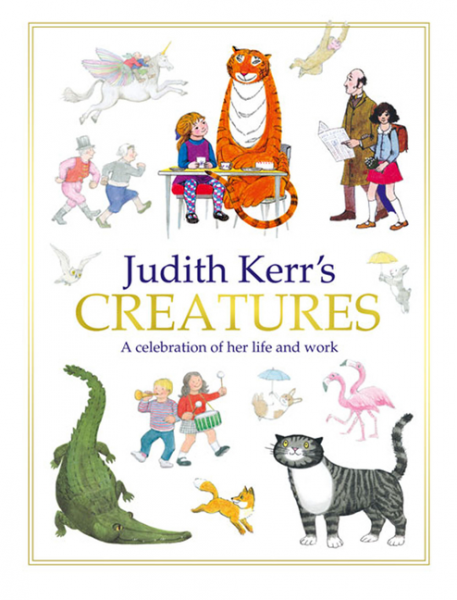If there’s anyone capable of succinctly—and without fanfare—summarizing the life of a young girl who barely escaped the clutches of the Nazis, lived as a refugee in Paris and then London during World War II, spoke three languages and taught herself how to draw and paint, wrote scripts for television when the medium was new, wrote three books for young adults and dozens of picture books, raised two children and created, with no formal training, a huge career as an illustrator and storyteller, it’s the woman who lived the life herself.
This is not simply because it is her story, but because she possesses a nonchalance about enduring hardship that makes her narrative all the more astonishing.
Judith Kerr is not a familiar name in most American households, but it should be. Here is the story of The Tiger Who Came to Tea, her first picture book: one day, a child and her mother are sitting at tea when the doorbell rings. It is a tiger, who wants to know if he can join them at the table. Sophie and her mother welcome him immediately. He has an enormous appetite and eats every last bit of their food. He even drinks all the water in the tap, forcing Sophie’s family to dine at a café for dinner. No one in the story shows any astonishment at this visitation.
Kerr specializes in introducing charming but vaguely sinister characters into her depictions of home life—if Wilkie Collins, master of Gothic sensation novels, had written children’s stories, they might look like Judith Kerr’s books.
Born to Jewish intellectuals in Berlin in 1924, Kerr and her family fled Germany just before the Nazis were elected in 1933. Had they waited three more days, they would have been arrested. Kerr describes the harrowing journey from Berlin to Switzerland in When Hitler Stole Pink Rabbit, her first book in a trilogy about her life as a refugee.
In Judith Kerr’s Creatures, a memoir that includes color images of sketches, designs, paintings, and charming family photographs, she discusses every era of her life, from refugee to fledgling artist, from young mother to accomplished novelist and illustrator.
That Kerr achieved so much after motherhood serves as inspiration to any woman afraid that her best years are behind her by the time her children go to school. Indeed, all of Kerr’s professional accomplishments occurred after early motherhood, although she had begun to form plans in the long hours she spent with her small children.
Perhaps it was in spending so much time with the ultimate freethinkers—toddlers—that Kerr realized outlandish tales were the most pleasurable sort for children. Her picture books were also inspired by the shenanigans of the family’s many eccentric cats. Kerr’s work masterfully depicts the absurd intruding on the domestic.
It is her nonchalance, her very British reserve about grief and loss that jumps from the pages of her memoir. It is something to behold, her elegant insistence that all the trials of her life were fairly routine matters, and furthermore, that she has experienced much good fortune.
Even when confronting widowhood, she is graceful. In My Henry, she pens a fond remembrance of a life lived side-by-side with her husband—writing together, chatting every day, never tiring of each other’s company. Each milestone, triumph, and loss was poured lovingly into her pictures and her books. It is left to us to marvel at her strength and courage; she has no interest in finding herself remarkable.





